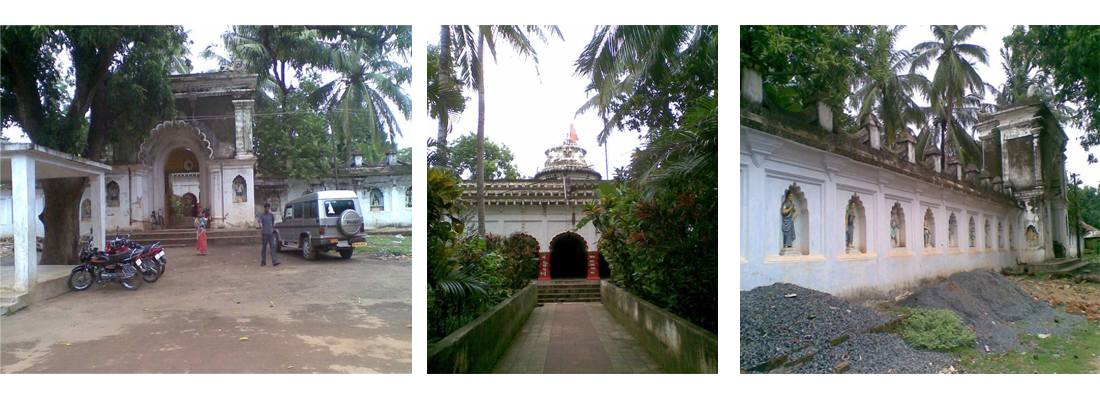

The Bhudaar Chandi Mandir is situated in a small village known as Sujanagarh near Nilgiri town approximately 25 K.M. from the headquarter city of Balasore . It is about 13 K.M. from the Sergarh junction on the national highway no -5. The famous temple of Goddess chandi was a centre of attraction for the Tantric ritual practitioners . As per the historical evidence this temple was built and established by the Nilgiri king Shri Vasanta Virata Bhujanga Mandhata (Ruled 1421 B.C. to 1464 B.C.). To strengthen and to coordinate his empire the king made this place his capital and he built another palace .He named this place “Sarojini” after his daughter princess, Sarojini. As with the running stream of the passing time the name mutated into Sujunagarh from Sarojini .

What mythology tells about this ancient Goddess temple –the King established the Goddess worship place inspired through a dream embodied by the Goddess Chandi. There was a dense unreachable forest near the King’s capital palace. As per the instruction of Devi Maa (Goddess) the King tried to find the Devi’s idol below a specified Neem tree. After many attempts and desperation he was unable to get the Devi’s Idol. After offering prayer Devi Maa again came to meet him through his dream. After the soothing advice and words of solace again encouraged the King to make a temporary worship place below that Neem tree. At that historical period the concerned place was an inhabitation for the Bhumijas and Bathudi tribes. From those tribes a person named as Dharial Pradhan was selected for the daily worship of Devi Maa. He was a Tantric .The worship rituals and norms for the Devi was therefore as according to the Tantric tradition. During that period ,the Devi Maa was being offered worship through the holy sacrifices of goats, ships and even in time of necessity there was system and tradition for Human sacrifices also. The process and rituals of these Bathudi and Bhumija priests were very violent and brutal. They were piercing themselves by sharp iron hooks on their back and thigh muscles then they were hanging themselves by those hooks from very tall columns/pillars(Udaa Khunta) in inverted positions . Indeed these processes were bloody and very painful .
After the King Virat Bhujanga Mandhata his son Prince Ramchandra Mardharaj Harichandan become the king of Nilgiri Raj.Like his father, he was also a great devotee of Devi Maa. He tried hard with his soldiers to dig the ground and recover the Devi Maa’s Idol, but all attempts turned out to be futile. All the weaponry and equipment were damaged but they could not dig a little hole below the Neem tree. The king arranged a big ceremony of worship and oblation fire at that place with fasting and hunger for several days. Devi Maa’s idol appeared and raised to the surface by itself after an earthquake like shock and cracking of the ground. So due to this region ,Goddess got her name of Bhudar Chandi (Meaning Goddess who appeared herself by rupturing the ground).
After the King Ramachandra Harichandan,his son Govinda Chandra Mardharaj took over the responsibilities to wear the royal crown. During his rule ,he lifted away the Tantric worship rituals and ceremonies and established the Brahmin system of rituals .From that day the Human and animal sacrifices ceased to celebrate.He appointed and hand over all the worship and traditional ceremonial right to a Brahmin priest named Late Shri Balabhadra Panda.
From those days until now his ancestors have been worshiping the Goddess Bhudar Chandi as their ancestral trait and responsibilities. At present the chief priest in charge of the temple is Shri Kruttivas Panda and also his son Shri Vijay panda.
This fascinating visible existing temple was reconstructed and rehabilitated by the King Shri Shyamsundar Mardharaj in between 1900 to 1905 .He was the grandson of the King Shri Govinda Chandra Mardharaj. King Shyamsundar Mardharaj established the goddess black granite rock statue in this newly built temple by the order of the Goddess through a dream. It is said through the folktales that the King had received a great fortune to be able to view the Goddess through his devotion and prayer.
The temple is surrounded in all directions by a big strong wall. The tale of epics, like Ramayana, Mahabharata etc. all inscribed and sculpted on the wall by several statues. The goddess is in a dancing posture with her face and head tilted toward left and upon the Sapta Varaha Vahana.The divine face of the Goddess seems mystic. This temple has 4 entrances openings in each direction. The sculpture and artefacts are unique combinations of Oriya and Bengali sculpture artists of those periods.
This temple management is fully under the DEVOTTAR BIBHAG . Among the head of the trustees the Queen Shrimati Indira Devi of Nilgiri Raj is the chief.
This temple bears its great history and folktales. This Goddess temple is the most SIDDHA among the devotees .This place is surrounded by various tourist places in that locality. Nearby are the attractive surroundings of Nilgiri hills and jungles, Kuldiha sanctuary,Panchaligeswar Hill and temples which mesmerises the mind of visitors.One can see so many natural waterfalls in Panchalingeswar Hills.Also there is an OTDC panthanivas near Panchalingeswar temple for the accommodation of faraway and VIP tourists .Throughout the year and specially in winter season there rises the tide of tourists to these places from outside of Odisha like Bihar ,West bengal,UP,Andhra pradesh etc.
|
Copyright @ Best Nutrition Products Inc. All Right Reserved |